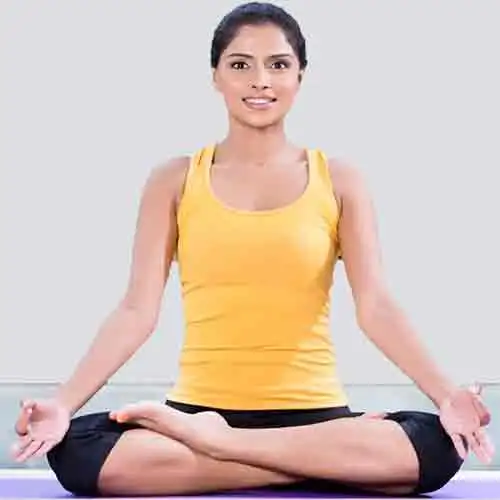Is Sitting Indian Style Bad for You?
All of us are familiar with the popular yoga sitting position. It is interesting to note that it is actually a traditional Indian way of sitting. For native Indian people, it is quite a common thing but for the non-natives, it can add considerable value to their life if practiced correctly.
Indian-style sitting is a sitting posture that is frequently used for its many health advantages, including improved flexibility, better posture, enhanced metabolism, increased blood circulation, and mind relaxation.
Is sitting Indian style bad for you? Like any other sitting position, it has some disadvantages as well if practiced wrong. Many people can find it uncomfortable, and experience hip pain while sitting Indian style, knee stiffness, or numbing sensation in the lower body if they sit too long in this position. Nonetheless, the health benefits of Indian-style sitting outweigh its demerits.
What is an Indian Sitting Style?

The Indian sitting style is a cross-legged sitting position that is frequently used in India and many other Asian cultures for meditation, prayer, and daily activities that involve sitting. It is also referred to as Sukhasana, Criss Cross Applesauce posture, or the Easy pose in yoga terms.
Indian sitting style may sound confusing to a lot of non-native people. It is usually mistaken for cross-legged sitting. However, both, Indian-style and cross-leged sitting positions, have a slight difference.
Cross-legged sitting means to sit on the floor with bent legs in such a way that the knees point outward, whereas sitting in the Indian style is chiefly linked to Sukhasana which means an easy pose. This position involves crossing your legs and not dangling them on the floor.
How do you Sit in Indian Style?
In order to sit in Indian style:
- Cross your legs over your knees as you sit down on the floor.
- Maintain a straight back and lay your hands on your knees with the palms facing up.
- For meditation, you can also position your hands in a certain way, in which the tip of your index finger contacts the tip of your thumb while the remaining fingers are left extended.
- As you sit comfortably in this position, try to keep your back straight, and breathing calm and steady.
Health Benefits of Sitting Indian Style
For both the mind and the body, sitting in Indian style can offer several advantages. Some of them are as follows:

Improves Posture:
Sitting in the Indian style keeps the spine straight and stretches the back, ankle, and knees. It forces your shoulders back. This sitting style maintains proper posture for all of the parts of your body that are prone to experience aches and pains frequently. Eventually, the posture improves. You can definitely stay healthy and fit by adopting this posture.
Enhances Flexibility:
Sitting in the Indian manner on a regular basis can make your knees and hips more flexible. It stretches and widens the hip joint, which is particularly helpful if you have tight hips due to spending a lot of time sitting on a chair. It makes the lower back flexible and your body much more robust than before.
Strengthens Back and Abdominal Muscles:
The Indian sitting posture activates your core muscles. It contracts and relaxes the abdominal muscles. Over time, this position can assist in building up, fine-tuning, and strengthening your back and abdominal muscles.
Relaxes the Mind:
The Indian form of sitting is basically a yoga pose. When you are doing your daily activities like eating meals in this position, you are automatically in a state of yoga. While sitting Indian style during mindful meditation, try to calm the mind and practice breathing techniques. It brings peace, focus, and clarity to the mind.
Increases Blood Circulation:
Sitting cross-legged can aid in increasing blood flow to the lower torso and legs. For those people who have blood circulation problems or spend a lot of time sitting at a desk, this sitting style can be helpful to boost their blood circulation.
Improves Digestion:
It has been demonstrated through science that an Indian-style natural setting is really good for overall gut health. In fact, specialists recommend that one should eat one’s meals while being seated in this manner. By encouraging a calm and open abdomen, the Indian-style posture ensures a better flow of digestive enzymes and helps improve digestion. It enables improved blood flow to the digestive system, which lessens the likelihood of any discomfort related to the gut.
Balances the energy flow:
Yoga and other ancient Indian practices hold that sitting in this position balances the flow of energy, or “prana” within the body and thus improves spiritual health. A person feels spiritually rejuvenated by adopting this sitting practice instead of a regular sitting style.
Is Sitting Indian Style Bad For You?
Sitting in Indian style, on the floor or chair, is not a bad practice as long as you’re switching positions between sitting and standing and keeping your body comfortable. If you sit Indian-style for long hours, here are the few health disadvantages you are likely to experience:
Strain on back and knees:
The Indian sitting style can be a comfortable and relaxed sitting position for short durations, but for extended periods it can cause a strain on the back, hips, and knees. It can lead to poor spinal alignment. A person will eventually feel exhausted instead of relaxed if he or she sits in the same cross-legged position for long periods of time.
Soring of neck and head muscles:
Your neck may get sore if you sit in an Indian sitting manner while working on a computer. You will most probably not be able to view the laptop screen at the correct angle. The monitor should be at such a distance that the user can focus on the screen. Moreover, the arms need to be parallel to the upper body. If this is not the case, an injury to the muscles supporting and moving the head and neck is the primary cause of neck strain.
Exacerbation of the already existing joint pain:

People who already have certain joint disorders or injuries can find it difficult to sit in the Indian style. In such a condition, there are high chances of knee pain, knee stiffness, and reduced joint flexibility.
It is pertinent to note that an individual’s age, weight, and general physical condition may influence the severity of knee issues brought on by Indian-style sitting. When knee or hip problems are present, Indian sitting posture should be avoided or adjusted accordingly.
Numbness in the lower body:
There also exists a valid viewpoint that sitting cross-legged may limit blood flow to the legs. A sensation of numbing and tingling can be induced in the lower extremities of the body. While extended sitting in any position has the potential to influence blood flow, brief periods of time spent cross-legged may not have a materially negative impact on circulation.
How Long Should You Sit Indian Style?
The duration for which one can comfortably sit in Indian style varies from person to person based on factors such as comfort, flexibility, and individual tolerance. However, in general, it is okay to sit still for 30 minutes before getting up or shifting positions. Some guidelines that should be considered in this matter are:
- Always pay attention to your body. If it does not initially feel comfortable, sit for shorter durations such as 15-20 minutes, and gradually increase the duration.
- Regular stretching can build your stamina to sit in Indian style for longer time periods.
- Take short breaks during sitting sessions to prevent knee and joint pain.
- For relaxation or meditation purposes, try to sit for shorter durations to prevent exhaustion.
Bottom Line!
The Indian sitting style has been practiced for thousands of years, even though it may appear to be a contemporary sitting style or something exclusive to yoga or meditation. This simple position is surprisingly effective, and it is the best way to avoid the tiredness that comes with prolonged chair use.
Despite some drawbacks, that too only for specific cases, this sitting technique is worth trying out because of its health benefits. It is, therefore, highly recommended to employ Indian sitting in daily lifestyle.







